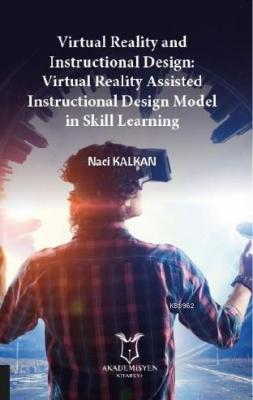9786257106719
504485

https://www.turkishbooks.com/books/virtual-reality-and-instructional-design-p504485.html
Virtual Reality and Instructional Design Virtual Reality Assisted Instructional Design Model in Skill Learning
4.8
1 CHAPTER
Introduction
2 CHAPTER
Virtual Reality
2.1. Concept of Virtual Reality
2.2. Historical Development of Virtual Reality
2.3. Virtual Reality System
2.3.1. Classification of Virtual Reality Systems
2.3.1.1. Fully-Immersive Systems
2.3.1.1.1. HTC VIVE
2.3.1.2. Semi-Immersive Systems
2.3.1.3. Non-Immersive Systems
2.3.1.4. Virtual Reality Headsets
2.3.1.4.1. Head-Mounted Display Headsets (HMD)
2.3.1.4.2. Mobile Based Virtual Reality
2.4. Virtual Reality and Learning
2.4.1. Advantages of Virtual Reality in Education
2.4.1.5. Realism
2.4.1.6. Entertainment
2.4.1.7. Motivation
2.4.1.8. Effectiveness
2.4.1.9. Practicality
2.4.1.10. Opportunity to Repeat
2.4.1.11. Instructive
2.4.1.12. Time
2.4.1.13. Variation
2.4.1.14. Experience
2.4.1.15. Place
2.5. Virtual Reality and Physical Activity
2.6. Studies on Virtual Reality
2.7. Virtual Reality and Learning Theories
2.8. Virtual Reality and Constructivism
2.9. Instructional Design
2.9.1. Instructional Design Models
2.9.1.1. Dick and Carey Model
2.9.1.2. Hannafin and Peck Model
2.9.1.3. Knirk and Gustafson Model
2.9.1.4. Jerrold Kemp Model
2.9.1.5. Gerleach and Ely Model
2.9.1.6. Rapid Prototype Model
2.9.1.7. Romiszowski Model
2.9.1.8. Syracuse Model
2.9.1.9. Diamond Model
2.9.1.10. Gagne, Briggs and Wager Model
2.9.2. Virtual Reality and Instructional Design Models
2.9.2.1. Chen's Model
Introduction
2 CHAPTER
Virtual Reality
2.1. Concept of Virtual Reality
2.2. Historical Development of Virtual Reality
2.3. Virtual Reality System
2.3.1. Classification of Virtual Reality Systems
2.3.1.1. Fully-Immersive Systems
2.3.1.1.1. HTC VIVE
2.3.1.2. Semi-Immersive Systems
2.3.1.3. Non-Immersive Systems
2.3.1.4. Virtual Reality Headsets
2.3.1.4.1. Head-Mounted Display Headsets (HMD)
2.3.1.4.2. Mobile Based Virtual Reality
2.4. Virtual Reality and Learning
2.4.1. Advantages of Virtual Reality in Education
2.4.1.5. Realism
2.4.1.6. Entertainment
2.4.1.7. Motivation
2.4.1.8. Effectiveness
2.4.1.9. Practicality
2.4.1.10. Opportunity to Repeat
2.4.1.11. Instructive
2.4.1.12. Time
2.4.1.13. Variation
2.4.1.14. Experience
2.4.1.15. Place
2.5. Virtual Reality and Physical Activity
2.6. Studies on Virtual Reality
2.7. Virtual Reality and Learning Theories
2.8. Virtual Reality and Constructivism
2.9. Instructional Design
2.9.1. Instructional Design Models
2.9.1.1. Dick and Carey Model
2.9.1.2. Hannafin and Peck Model
2.9.1.3. Knirk and Gustafson Model
2.9.1.4. Jerrold Kemp Model
2.9.1.5. Gerleach and Ely Model
2.9.1.6. Rapid Prototype Model
2.9.1.7. Romiszowski Model
2.9.1.8. Syracuse Model
2.9.1.9. Diamond Model
2.9.1.10. Gagne, Briggs and Wager Model
2.9.2. Virtual Reality and Instructional Design Models
2.9.2.1. Chen's Model
1 CHAPTER
Introduction
2 CHAPTER
Virtual Reality
2.1. Concept of Virtual Reality
2.2. Historical Development of Virtual Reality
2.3. Virtual Reality System
2.3.1. Classification of Virtual Reality Systems
2.3.1.1. Fully-Immersive Systems
2.3.1.1.1. HTC VIVE
2.3.1.2. Semi-Immersive Systems
2.3.1.3. Non-Immersive Systems
2.3.1.4. Virtual Reality Headsets
2.3.1.4.1. Head-Mounted Display Headsets (HMD)
2.3.1.4.2. Mobile Based Virtual Reality
2.4. Virtual Reality and Learning
2.4.1. Advantages of Virtual Reality in Education
2.4.1.5. Realism
2.4.1.6. Entertainment
2.4.1.7. Motivation
2.4.1.8. Effectiveness
2.4.1.9. Practicality
2.4.1.10. Opportunity to Repeat
2.4.1.11. Instructive
2.4.1.12. Time
2.4.1.13. Variation
2.4.1.14. Experience
2.4.1.15. Place
2.5. Virtual Reality and Physical Activity
2.6. Studies on Virtual Reality
2.7. Virtual Reality and Learning Theories
2.8. Virtual Reality and Constructivism
2.9. Instructional Design
2.9.1. Instructional Design Models
2.9.1.1. Dick and Carey Model
2.9.1.2. Hannafin and Peck Model
2.9.1.3. Knirk and Gustafson Model
2.9.1.4. Jerrold Kemp Model
2.9.1.5. Gerleach and Ely Model
2.9.1.6. Rapid Prototype Model
2.9.1.7. Romiszowski Model
2.9.1.8. Syracuse Model
2.9.1.9. Diamond Model
2.9.1.10. Gagne, Briggs and Wager Model
2.9.2. Virtual Reality and Instructional Design Models
2.9.2.1. Chen's Model
Introduction
2 CHAPTER
Virtual Reality
2.1. Concept of Virtual Reality
2.2. Historical Development of Virtual Reality
2.3. Virtual Reality System
2.3.1. Classification of Virtual Reality Systems
2.3.1.1. Fully-Immersive Systems
2.3.1.1.1. HTC VIVE
2.3.1.2. Semi-Immersive Systems
2.3.1.3. Non-Immersive Systems
2.3.1.4. Virtual Reality Headsets
2.3.1.4.1. Head-Mounted Display Headsets (HMD)
2.3.1.4.2. Mobile Based Virtual Reality
2.4. Virtual Reality and Learning
2.4.1. Advantages of Virtual Reality in Education
2.4.1.5. Realism
2.4.1.6. Entertainment
2.4.1.7. Motivation
2.4.1.8. Effectiveness
2.4.1.9. Practicality
2.4.1.10. Opportunity to Repeat
2.4.1.11. Instructive
2.4.1.12. Time
2.4.1.13. Variation
2.4.1.14. Experience
2.4.1.15. Place
2.5. Virtual Reality and Physical Activity
2.6. Studies on Virtual Reality
2.7. Virtual Reality and Learning Theories
2.8. Virtual Reality and Constructivism
2.9. Instructional Design
2.9.1. Instructional Design Models
2.9.1.1. Dick and Carey Model
2.9.1.2. Hannafin and Peck Model
2.9.1.3. Knirk and Gustafson Model
2.9.1.4. Jerrold Kemp Model
2.9.1.5. Gerleach and Ely Model
2.9.1.6. Rapid Prototype Model
2.9.1.7. Romiszowski Model
2.9.1.8. Syracuse Model
2.9.1.9. Diamond Model
2.9.1.10. Gagne, Briggs and Wager Model
2.9.2. Virtual Reality and Instructional Design Models
2.9.2.1. Chen's Model
Yorumlar (0)
Yorum yaz
Bu kitabı henüz kimse eleştirmemiş.











